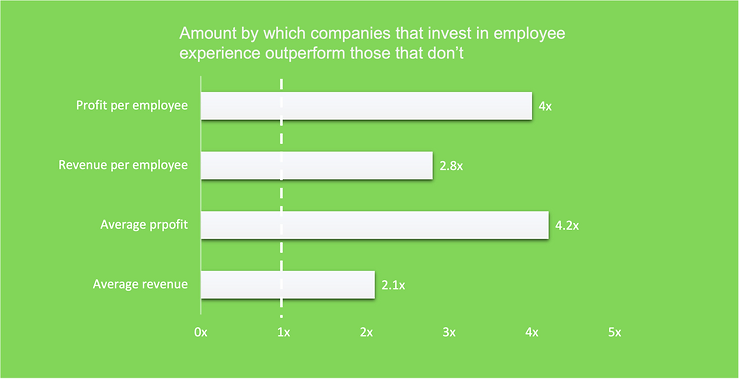What is employee experience and why is it so important?
Employee experience (EX), or how your employees feel about working for you, can make or break your organization and determine your company’s success.

It’s one of the most important aspects of any business: satisfied employees are less likely to quit their job, and are also more productive and engaged – and, as a result, they help companies thrive.
Even though most companies understand that, only 13% of employees feel completely satisfied with their experience at work, according to a Gartner study – and this is not necessarily due to a lack of willingness from business and HR leaders.
Often, companies don’t have a comprehensive employee experience strategy in place and concentrate on one-off initiatives, for example, to improve employee engagement or decrease turnover rates. While these can help address specific issues, they’re only band-aid solutions: Companies often fail to identify the root causes of employee dissatisfaction and are prone to treating symptoms only superficially. In most instances, this approach doesn’t contribute to meaningful long-term improvements.
In this blog post, we’ll talk about the importance of employee experience and how it can affect business results (including the customer experience). We’ll give you specific tips on how to make your employees happy, improve employee engagement, and also help you build a meaningful employee experience strategy.
What is employee experience – and why is it important?
Simply put, employee experience is the way your employees perceive their job and your company. It encompasses all interactions during the entire employee lifecycle and affects employees’ well-being, sense of purpose, motivation, and job satisfaction.
In order to understand, measure and improve EX, first you need to understand and map all the interactions that your employees have with your company in the context of an employee-employer relationship, assess which ones are positive and which ones are negative contributors, pick those with the biggest impact and then improve on them.
People-centric companies that understand this and build an environment that enables their employees to thrive will see an improvement in employee productivity and in business performance, as well. According to a report by the IBM Smarter Workforce Institute, organisations that score in the top quartile of employee experience report a double return on sales compared to organisations in the bottom 25%.
Additionally, they’re able to attract and retain talent even in highly competitive industries and fill skills gaps before they lead to poor performance.
A bad employee experience can drive people away – both future employees and customers. Unhappy employees won’t put much effort into providing a stellar customer experience, are more likely to leave the company, and will share their negative experiences with others. This will inevitably lead to reputational damage if you fail to manage the employee experience proactively.
How do you create a positive employee experience at your organisation?
To improve the employee experience at your company, you need a comprehensive employee experience strategy. This comprises many different elements, which we’ll discuss in this section.
1. Provide seamless access to the resources employees need
Providing everyone with the resources they need to excel is the foundation of good work and a necessary condition to the success of your organization and your employees; for this reason, it also has a direct impact on the employee experience. To provide every employee with the resources they need, you need to:
2. Have a clear onboarding process that you communicate to employees in advance
Set up an onboarding process that is highly digitised, with minimal admin charge or friction (such as exchanging too many emails with too many people in different departments). This sets the tone of the employee journey and makes a lasting first impression: We are here to get things done.
3. Provide modern and performant equipment
Deliver modern, high-quality equipment to your employees before the start date, replace it quickly in case of problems or damages, and try to automate overhead arising from security policies. This can be challenging in remote setups, where delivery very often leads to delays, and administrators cannot physically touch the device to set it up, especially if it’s international. Modern device management software and outsourced international equipment providers can help.
4. Provide easy access to core systems and productivity tools
Clearly communicate what core systems productivity tools your organisation is using. Make sure access is correctly set up before the employee joins, and that you can make changes easily, when needed. Once an employee is used to working with a certain set of tools – even if they were incorrectly set up or if some are missing – it is hard to change their behaviour.
5. Set clear goals and objectives
Define what success looks like at an individual and team level, and communicate your expectations and requirements clearly and in time. Using the right tools and systems can make all the difference in creating a clear framework for your employees.
One of the best ways to do all this seamlessly is to use a modern employee platform centered around the needs of employees. It helps keep everything organized, easy to access and gives you real-time visibility into all processes, devices, and accounts.
Note that this is different to an HRIS, which is mostly focused on providing HR managers with tools for their job function and introduces a hierarchical structure between employees and the employer that is not employee-centric.
When employees have what they need to do their jobs well, they’re much more likely to be satisfied with their work and be motivated.
6. Provide growth opportunities tailored to your employees’ talents
One of the most important things you can do to improve the employee experience is to provide your staff with opportunities to grow and develop within the company.
This could include offering relevant training and development programs, giving employees the chance to take on new and challenging projects, or providing mentorship or certification opportunities.
Career growth and development are essential for keeping employees happy and engaged in their work: According to a Gallup study, 87% of millennials consider growth opportunities to be very important for their job satisfaction.
7. Improve your organisational culture
Company culture is a key element to creating a positive employee experience, and the first step towards building cohesion between the two is understand what culture you currently have by performing a culture assessment.
The purpose of the assessment is to help you make sure your company values are aligned with the way you want your employees to feel, and that your policies and practices support those values. For this, you need to bring clarity to what your company culture is like at the moment, and steer it in the right direction, if needed.
Some examples:
- If you value collaboration, make sure you have systems and processes in place that enable and encourage teamwork.
- If you want to create a diverse workplace, make sure you’re giving everyone equal opportunities and access to resources.
- If you value experimentation and innovation, frame mistakes as learning opportunities rather than as a failure to avoid at all costs.
According to Research and McKinsey, the most successful organisational form for startups are adhocracies. An adhocracy is an informal, organic and fluid organisational structure staffed by professionals with high levels of expertise. Control comes rather from lateral co-ordination than to traditional hierarchy. It is because of these characteristics that adhocracies are particularly beneficial for knowledge sharing, workplace collaboration and rapid adaptation – some of the most important attributes for companies in the knowledge-based age.
Whatever the culture you are aiming for it is important to note that culture is eroded by friction which employees experience in their employee journey, for example as a result of bureaucracy, admin, inefficient people operations or clunky admin tools like HRIS, payroll or access management which are not centered around needs of employees but of admins and stakeholders.
8. Invest in the physical work environment
The physical environment at your workplace – or at home, if your employees are working remotely – can have a big impact on employee experience. Make sure that:
- Office spaces are clean, comfortable, and well-lit
- Employees have the ergonomic furniture and equipment they need
- Employees have the necessary amenities that help them relax and recharge
- If your employees are working from home, make sure they have the right conditions to work. Provide an adequate budget for home office furniture and equipment, or for a subscription to a coworking space.
It’s important to provide the high quality hardware, so that employees don’t have to waste time with computers that are slow or crash often. This doesn’t have to be a huge investment, either: For example, new Macbook Pros can be rented for just £60 per month and will make your employees feel appreciated and set up for success from day one.
Keep in mind, however, that the requirements for adequate device protection in a remote setup have increased significantly, which can be disruptive to employees’ day-to-day work, if not handled correctly. For this reason, you need to make sure that device security enforcement is seamless and doesn’t stand in the way or slow down the work of your employees. You can achieve this by integrating it into your own HR system, or by using a unified workspace platform.
In addition to the above, the best way for remote companies to address employees’ needs is to actually ask them what would make the most sense for them. Assisting with childcare arrangements, for example, might be much more valuable than simply allocating a budget for new equipment.
9. Encourage open communication
Open communication is essential for creating a positive employee experience.
Show employees they can share their ideas, concerns, and feedback openly and without fear of retribution. Listen to what they have to say, and take action on their suggestions whenever possible.
If you are not sure how to communicate effectively with your team, learn more about the types of communication and how to use them to enhance engagement.
One-to-one conversations are important and will allow you to get an in-depth understanding of how employees feel at work, but not everyone might feel comfortable sharing their experiences with their direct managers, especially if communication between them is strained. You can also use employee surveys to collect feedback anonymously.
For this to be effective, you need to act on employee feedback in time and show your employees they’re heard and valued. Otherwise, you risk creating resentment, which will negatively impact employee engagement and motivation.
Employees will not always raise their hand if they’re dealing with inefficient admin processes, such as late or incorrect salary payments, a lack of clarity around benefits and pensions, or not having access to company systems. The digitization of employee processes can help you overcome this and further improve communication.
10. Show appreciation for your employees’ work
Employees who feel appreciated for their contributions are more likely to be happy and engaged in their work.
Monetary rewards, such as bonuses and pay raises, are obviously very important. However, you need to be careful with this approach: Once you start giving additional monetary incentives, it is very hard to turn back from them and can lead to the opposite effect if not given when or in the amount expected. According to studies, monetary rewards can even harm intrinsic motivations which employees have independent of money.
However, there are many more ways to show appreciation, such as:
- Public recognition (remember: criticize in private, praise in public)
- Adequate career growth opportunities
- New challenges that help employees develop their skills.
- Encourage employees to support each other, as well. HR systems which are built around the employee experience can help with this: Employees can give each other positive feedback or public kudos on the company’s social feed.
Don’t forget the small gestures, too: even an impromptu thank-you message or a surprise gift card can go a long way.
11. Use a HR platform that automates people operations
Another easy way to improve employee experience is to use a modern employee platform, which is centered around the needs of employees and allows you to manage:
- The relationship with your employees
- The tools employees want to use (software, hardware)
- The compensation package employees expect (pay, benefits, pensions, time off)
- Processes and workflows in an automated way (approvals, requests, etc.)
- This provides employees with a single point of access to all resources they need to do their job, and also to an admin interface where they can request days off, see their payslips, and manage their pension contributions.
This is particularly important in a hybrid or remote work environment. If crucial information and employer services are scattered, or if administrative and managerial processes are sluggish or inefficient, or if employees have to chase admins for things they consider personal (pay, benefits, time off, etc.) this will inevitably result in friction during the employee journey, and harm the employee experience.
How can a unified workspace platform help improve the employee experience?
A modern HR platform that combines payroll, HRIS, and account & device management, helps improve employee experience in many ways. It enables you to:
Reduce overheads
Manage HR, payroll and IT in a single system and automate the things that distract you from achieving your mission. This helps in two ways: admin information and HR procedures become much more transparent and easy to navigate, and it frees up resources that you can invest elsewhere to improve employee happiness.
Facilitate communication between you and your staff
Collecting everything in one place makes it simpler to build a positive relationship with your workers and foster trust. Faster feedback loops on regular administrative and managerial processes improve communication and give employees a sense of visibility and control over their employee journey.
Improve onboarding and offboarding processes
It’s easier to provide positive onboarding and offboarding experiences for all employees if you have a clear process in place, as well as a system that enables you to execute it seamlessly each time. Employee onboarding and offboarding span across all company departments and systems, including HR, finance, legal and IT, which creates many possible points of failure. For this reason, it’s important to have everything in one place and create highly optimised and efficient processes.
Eliminate security vulnerabilities
Having real-time visibility into the status of all devices and access rights to company apps enables you to address and prevent security vulnerabilities immediately. You can disable or block accounts across all company apps when you offboard employees and locate, block, or wipe lost or stolen devices in a few clicks.
What are some things that can affect employee experience negatively and lead to employee attrition?

There are a number of pitfalls to avoid when building an employee engagement program and trying to improve the employee experience. They can undermine your efforts and lead to poor results, both in terms of engagement and performance.
Poor change management
Transforming organisations is difficult – but it’s an absolute necessity in today’s dynamic business environment. Resilience depends on how companies manage to navigate change and adapt to it.
A lack of an adequate change management strategy can quickly lead to employee disengagement as people become frustrated with the process and feel like they’re being left behind.
There are four main factors that business leaders need to consider when implementing change:
Duration and assessment
A common belief is that the longer an initiative takes to implement, the less successful it will be, and the more employee experience will suffer. This isn’t necessarily true: how often you assess results turns out to be more important than just the duration. Bimonthly reviews are a good starting point.
Alignment between long-term vision and day-to-day tasks
Day-to-day work performance shouldn’t suffer during periods of transformation, nor should change be put on the back burner while dealing with urgent tasks. For this, you need to engage everyone, and not just rely on top performers to carry out the change.
Commitment from all levels
Similarly, securing commitment to change from everyone is key. Not only does the executive team need to be on board, but also all employees who’ll need to work with the new systems, processes, and applications. Simply reaching out to the members of your team, communicating key objectives clearly, and requesting employee feedback, can help with employee engagement during transitional periods.
A realistic assessment of the available resources
To maintain productivity levels and ensure a positive employee experience throughout, you need to make sure you have the necessary resources available.
Consider putting low-priority projects on hold to free up resources, as well as using the right tools for workforce management (including payroll and HR software) to gain maximum visibility into your assets.
Failing to understand what employees need and want
In order to improve the employee experience, you first need to understand what employees are looking for. Conducting regular employee surveys and using focus groups is a great way to measure engagement, collect employee feedback, and get insights into your workers’ needs and wants. It’s not enough to just communicate survey results to employees, though – you also need to take swift action based on the feedback you receive. Failing to do so will only lead to further disengagement as employees feel like their voices are not being heard.
Pulse survey tools can be very helpful for figuring out what your employees need, as well as regular one-to-one conversations.
Remember to also conduct exit interviews and exit surveys to better understand how employees perceive you as an employer and collect honest feedback from the ones who are quitting. They might be more open to sharing negative experiences that impact employee satisfaction, which is precious information you can use to revise management practices.
Lack of communication and transparency
Change can be daunting, especially if employees feel like they’re being left in the dark. A lack of communication is one of the main reasons people become disengaged at work.
To avoid this, keep your employees updated on changes happening within the company, and solicit their feedback frequently. Explain how the changes will impact their work, and give them a chance to voice concerns.
Another common mistake is not involving employees in the decision-making process. Asking your employees for their input shows that you value their opinion and that you’re open to considering different perspectives.
Employees have a personal and professional stake in the organization when they’re involved in making decisions, which helps build trust, loyalty, and commitment.
Make sure you have all the necessary communication tools in place, and that employees can reach you easily and get all the information they need from a single interface, such as a unified workspace platform.
Lack of accountability
In any organisation, there needs to be a clear plan for who’s responsible for what. This helps ensure tasks are completed on time and that everyone knows their role in the process. A lack of accountability can lead to:
- Poor morale and decreased employee engagement
- Ineffective execution
- High turnover and absenteeism.
- Recognising and rewarding employees for their hard work – and also providing negative feedback in a constructive manner – is a crucial part of the employee experience. Failing to do so can lead to a feeling of devaluation and resentment.
How can you measure employee experience?

Setting goals and tracking results are two of the cornerstones of effective employee experience management. This means defining objectives and measuring employee experience continuously, in order to see what’s improving and what isn’t. The HR team needs to track the relevant EX metrics throughout the employee lifecycle and use the right methods and tools.
So, how can you measure something as abstract as employee experience? What are the metrics you need to track?
Note down initiatives
First of all, you need to track the initiatives you’re undertaking to improve the employee experience, such as:
- Certification and mentorship programs
- A clear and transparent bonus structure
- Creating a better work-life balance with flexible hours and more time off
- Investments in the physical workspace
- Hiring process improvements (such as shortening the recruiting cycle)
- Ongoing performance conversations with staff members
- Implementing a unified workspace platform
- For each of these initiatives, you can track the starting date, the investment you’re making, and the expected results. Then, you can see how the employee experience is evolving with time.
Track employees’ perceptions
Employees’ perceptions are the essence of the employee experience. You need to track how your workers feel about their job, their team, the workplace culture, and their career prospects.
This can be achieved in several ways, such as by using surveys, focus groups, and interviews with employees (including exit interviews). Use questionnaires where employees can rate how they’re feeling about different aspects of their job and the work environment.
You need to perform these throughout the employee journey at regular intervals, share results with team members, and discuss the measures you plan to implement.
You need to also check company review sites like Glassdoor (or local alternatives) to see what employees are saying about your company and track how your company score is evolving.
Track outcomes
The next step is to track the outcomes of your efforts to improve the employee experience. Outcomes you might wish to track include:
1. Employee satisfaction
Improving satisfaction is often the first desired outcome for organizations. Track employee satisfaction with regular surveys.
2. Customer satisfaction
Customer satisfaction is tightly related to employee satisfaction, and you’ll notice that both often improve together. (If they don’t, you need to look into the reasons why.)
3. Productivity
This is a key outcome that you’ll want to track, as it has a direct impact on the company’s bottom line. Research shows that organizations that manage to improve employee engagement see a 17% increase in productivity. Using a UK performance management software can help you measure and improve productivity by tracking performance consistently and providing insights for employee development.
4. Employee retention and employee churn
High employee turnover can be costly and damaging to a business. Tracking employee retention, as well as employee attrition and turnover rates, will help you see whether your efforts are having the positive impact you expect.
5. Employee engagement
Low engagement can lead to decreased productivity, job dissatisfaction, and higher employee turnover. To measure employee engagement, you can use Gallup’s Q12 survey, featuring the 12 most important engagement-related questions.
The employee experience is a vitally important aspect of any business. By taking the time to understand what it is and how to measure it, you can ensure that your workers are happy and productive. This, in turn, will lead to a better customer experience and give you a strong competitive advantage.
Conclusion
The new era of employee experience is here: Sustaining a positive employee experience over time will help you drive employee engagement and better business performance. Employee experience shouldn’t be left to human resources alone, but needs to be managed by both business and HR leaders.
Efforts to improve employee engagement will have a direct impact on your employer brand, which helps you attract top talent: Candidates assess future employers in the same way that employers evaluate candidates.
Millennials, in particular, as a highly educated and connected segment of the workforce, approach a job with the mentality “What’s in it for me?” – so, to attract and retain them, you need to take good care of their experience at your company.


